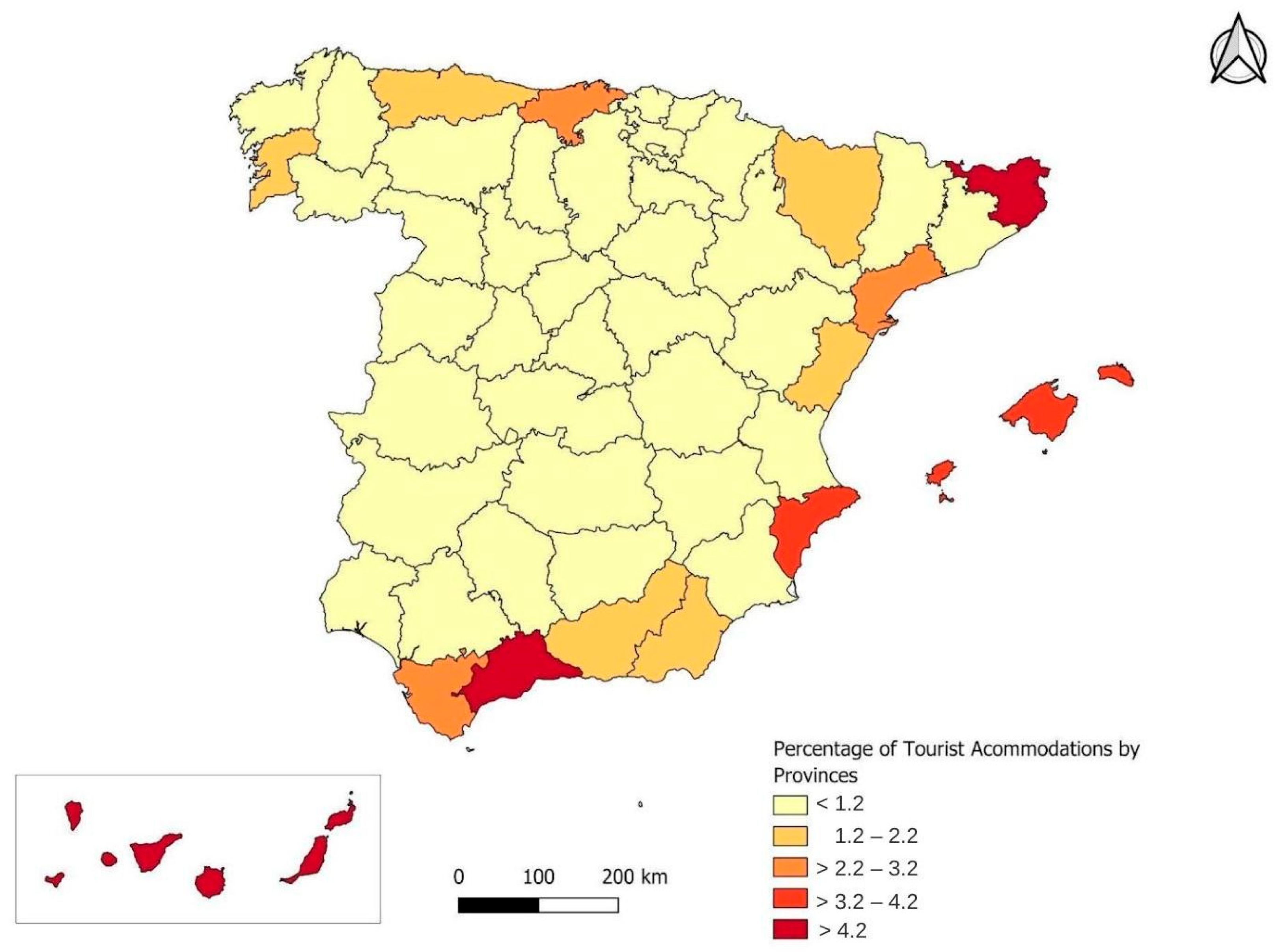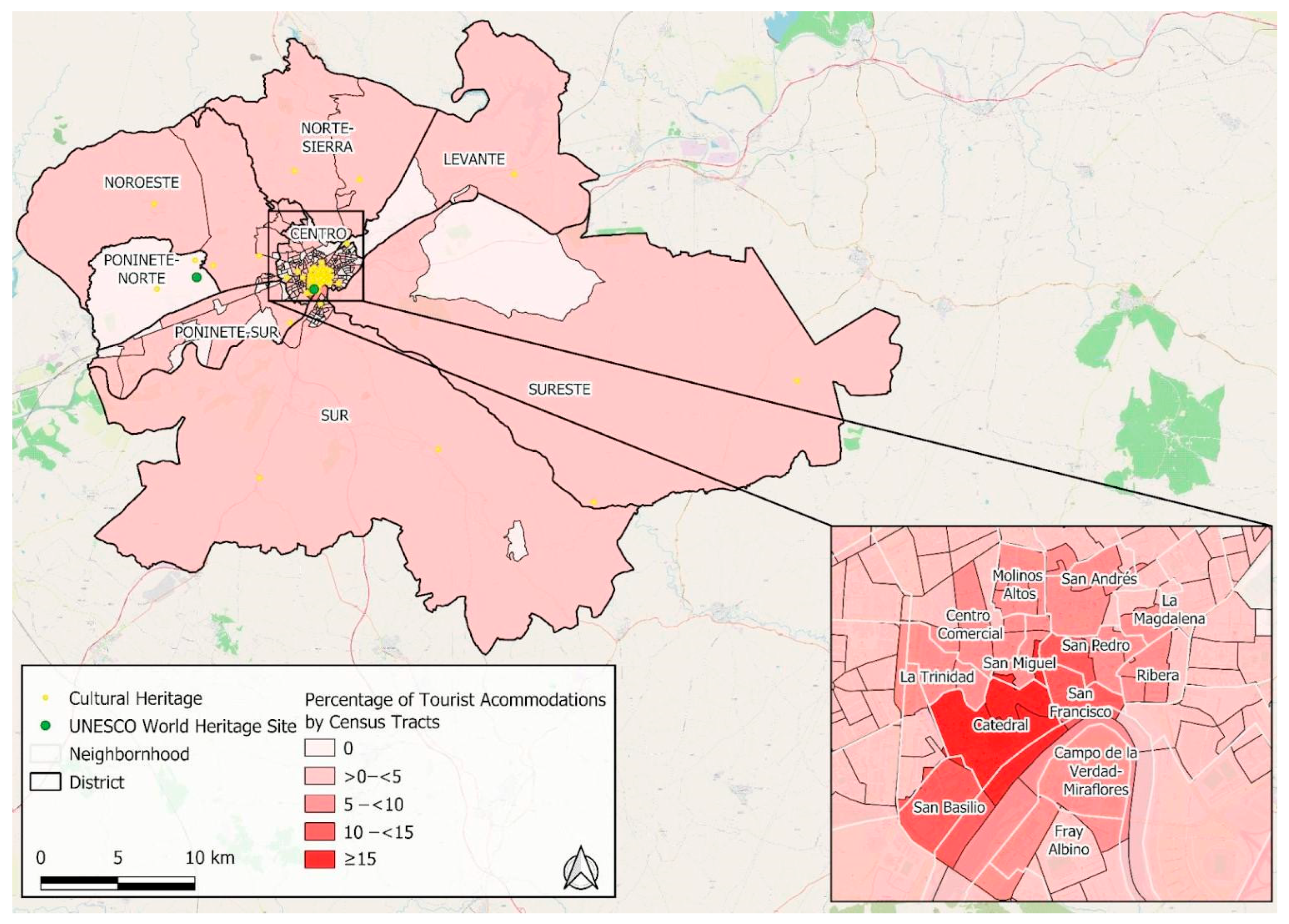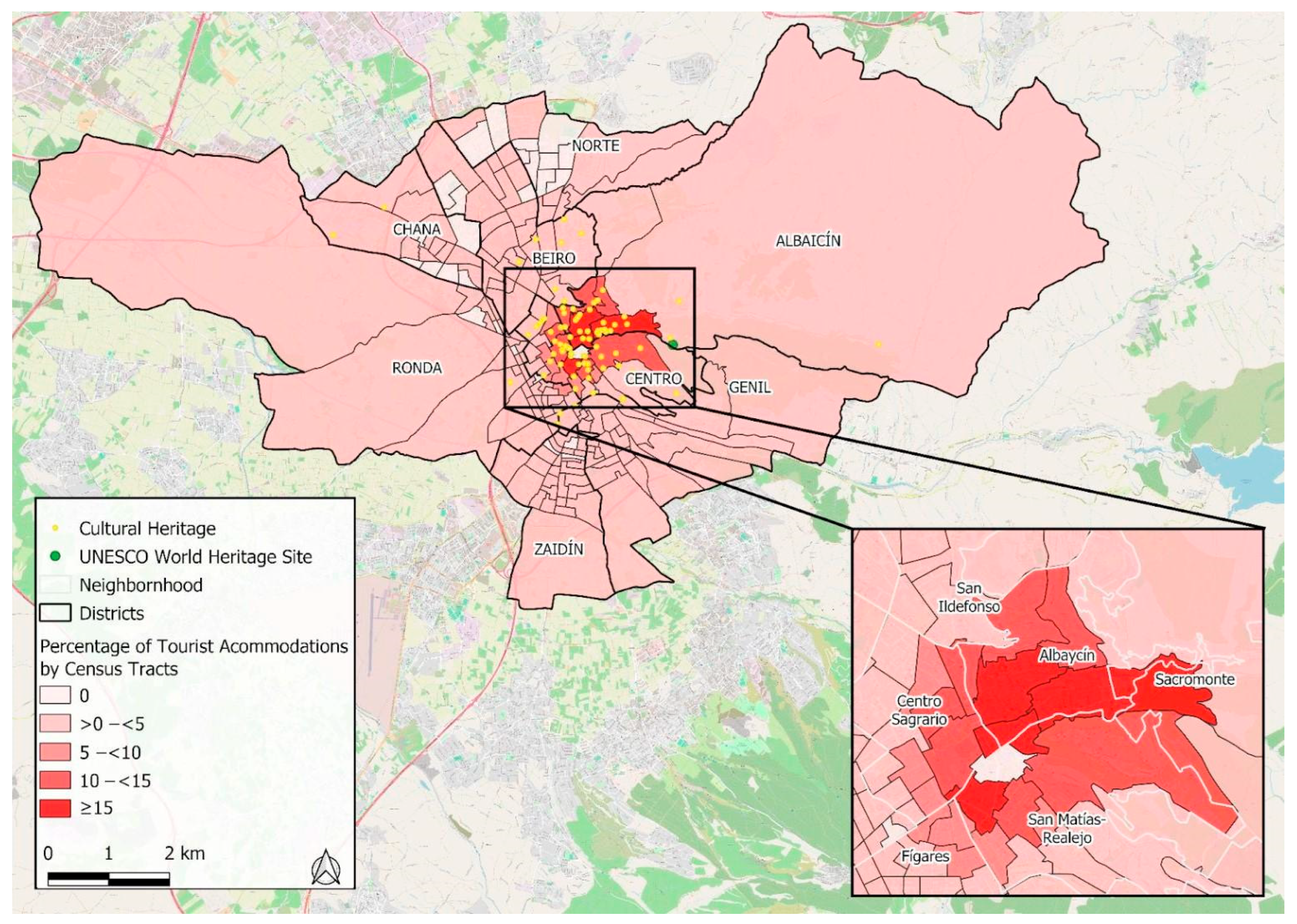Recent Trend and Outlook of Tourist Accommodations in Spain at Various Scales: The Challenges of Touristification in Andalusian Municipalities
Abstract
1. Introduction
2. Materials and Methods
3. Results
3.1. Characterization of the Tourist Housing Phenomenon at Different Spatial Scales in Spain
3.2. Application of the Hierarchical Urban Saturation Index (HUSI) to the Four Andalusian Cities Under Study
3.3. Touristification and Heritage Accessibility: Insights from Urban Case Studies
4. Discussion
5. Conclusions
Author Contributions
Funding
Institutional Review Board Statement
Informed Consent Statement
Data Availability Statement
Conflicts of Interest
Abbreviations
| BIC | Bienes de Interés Cultural |
| DERA | Datos Espaciales de Referencia de Andalucía |
| GDP | Gross Domestic Product |
| HPI | Heritage Proximity Index |
| HUSI | Hierarchical Urban Saturation Index |
| IECA | Instituto de Estadística y Cartografía de Andalucía |
| INE | Instituto Nacional de Estadística |
| INESEM | Instituto Europeo de Estudios Empresariales |
| ITHPI | Integrated Tourist-Heritage Pressure Index |
| NUTS | Nomenclature of Units for Territorial Statistics |
| RDw | Residential Dwelling |
| STRs | Short-Term Rentals |
| TRS | Tourist Rental Saturation |
| UN | United Nations |
| UNESCO | United Nations Educational, Scientific and Cultural Organization |
References
- Almeida-García, F., Cortés-Macías, R., Mena-Navarro, A., & Coll-Ramins, M. A. (2023). Perceptions of touristification according to place of residence in the destination: The case of Malaga. Boletín de la Asociación de Geógrafos Españoles, (99), 1–38. [Google Scholar] [CrossRef]
- Almeida-García, F., Monserrat-Febrer, A., Cortés-Macías, R., & Coll-Ramis, M. À. (2025). Touristification and expansion of short-term rentals in mediterranean destinations: The case of rural areas. Land, 14(4), 881. [Google Scholar] [CrossRef]
- Altaba Tena, P., Ginés Sánchez, X., Querol Vicente, V. A., & García-Esparza, J. A. (2025). Unpacking world heritage cultural clusters through the interplay of urban tourism and gentrification. Cities, 158, 105634. [Google Scholar] [CrossRef]
- Andalucía2030. (2025). El turismo en Andalucía: Oportunidades y desafíos en el siglo XXI. Available online: https://andalucia2030.org/el-turismo-en-andalucia-oportunidades-y-desafios-en-el-siglo-xxi/ (accessed on 26 March 2025).
- Assemblea de Barris pel Decreixement Turístic. (n.d.). Assemblea de barris pel decreixement turístic. Available online: https://assembleabarris.wordpress.com/ (accessed on 17 May 2025).
- Barrera-Fernández, D., Bujalance, S. G., & Scalici, M. (2019). Touristification in historic cities: Reflections on Malaga. Revista de Turismo Contemporâneo, 7(1), 93–115. [Google Scholar] [CrossRef]
- Barrero Rescalvo, M. (2019). Algo se muere de las Setas a la Alameda. Efectos del turismo sobre la población y el patrimonio en el casco norte de Sevilla. Revista PH, 98, 46–49. [Google Scholar] [CrossRef]
- Barrero Rescalvo, M., & Díaz Parra, I. (2024). Short-term rentals’ supply-side structure and the struggle for rent appropriation: Insights from Andalusia, Spain. Environment and Planning A: Economy and Space, 56(2), 508–524. [Google Scholar] [CrossRef]
- Barrero Rescalvo, M., & Jover Báez, J. (2020). Paisajes de la turistificación: Una aproximación metodológica a través del caso de Sevilla. Cuadernos Geográficos, 60(1), 13–34. [Google Scholar] [CrossRef]
- Blanco-Romero, A., & Blázquez-Salom, M. (Eds.). (2023). Spanish tourism geographies. Territorial diversity and different approaches. Springer. [Google Scholar] [CrossRef]
- Bonal, X., & González Motos, S. (2023). The spatially uneven effects of a desegregation education policy. European Educational Research Journal, 24(1), 30–47. [Google Scholar] [CrossRef]
- Camarillo-Naranjo, J. M., Vallejo-Villalta, I., Fernández-Tabales, A., & Santos-Pavón, E. (2022). Where is tourist housing actually located? New approaches and sources for detailed scale analysis. European Planning Studies, 30(4), 744–768. [Google Scholar] [CrossRef]
- Cao, K., Harris, R., Liu, S., & Deng, Y. (2024). How does urban renewal affect residential segregation in Shenzhen, China? A multi-scale study. Sustainable Cities and Society, 102, 105228. [Google Scholar] [CrossRef]
- Castro Noblejas, H., Sortino Barrionuevo, J. F., & Orellana Macías, J. M. (2023). Mapping method for the integrated analysis of gentrification and touristification: The case of Málaga (Spain). Cuadernos Geográficos, 62(1), 109–129. [Google Scholar] [CrossRef]
- Cerezo-Medina, A., Romero-Padilla, Y., García-López, A., Navarro-Jurado, E., Sortino-Barrionuevo, J. F., & Guevara-Plaza, A. (2022). Comparative analysis of short-term rental homes and traditional accommodation in Andalusian tourist cities: Intensity, density, and potential expansion areas. Current Issues in Tourism, 25(11), 1782–1797. [Google Scholar] [CrossRef]
- Chamizo-Nieto, F. J., Nebot-Gómez de Salazar, N., Rosa-Jiménez, C., & Reyes-Corredera, S. (2022). Indicators for measuring tourism intensification in urban areas through their associative network: Case studies from the Spanish Mediterranean coast. European Journal of Tourism Research, 32, 3202. [Google Scholar] [CrossRef]
- Click and Home. (2025). Nuevo decreto viviendas turísticas Andalucía. Available online: https://clickandhome.es/blog/nuevo-decreto-viviendas-turisticas-andalucia/ (accessed on 17 April 2025).
- De la Calle Vaquero, M., Mínguez García, C., & García Hernández, M. (2023). The touristification of urban spaces: Measurement proposal. Boletín de la Asociación de Geógrafos Españoles, (99), 1–33. [Google Scholar] [CrossRef]
- Díaz Cuevas, P., & Fernández Tabales, A. (2023). De la función residencial a la función turística en los espacios urbanos: Medición de los factores causantes a partir de herramientas digitales. Boletín de la Asociación de Geógrafos Españoles, (99), 1–30. [Google Scholar] [CrossRef]
- Fernández Aragón, I., & Lavía Martínez, C. (2020). The use of factor analysis in urban research: The case of the metropolitan area of Bilbao. In M. Smagacz-Poziemska, M. Gómez, P. Pereira, L. Guarino, S. Kurtenbach, & J. Villalón (Eds.), Inequality and uncertainty (pp. 225–249). Palgrave Macmillan. [Google Scholar] [CrossRef]
- Ferro, L., György, E., Oláh, G., Teixeira Lopes, J., Sonkoly, G., Apolinário, S., Azevedo, N., & Ricardo, J. (2024). Gentrification and touristification in urban heritage preservation: Threats and opportunities. Cultural Trends, 1–16. [Google Scholar] [CrossRef]
- Florido-Benítez, L. (2023). English, German, and French tourists are key to the success of andalusian destinations (Spain). Sustainability, 15, 12521. [Google Scholar] [CrossRef]
- Font, X., Torres-Delgado, A., Crabolu, G., Palomo Martinez, J., Kantenbacher, J., & Miller, G. (2021). The impact of sustainable tourism indicators on destination competitiveness: The European tourism indicator system. Journal of Sustainable Tourism, 31(7), 1608–1630. [Google Scholar] [CrossRef]
- Galacho-Jiménez, F. B., & Reyes-Corredera, S. (2024). Spatial analysis model for the evaluation of the territorial adequacy of the urban process in coastal areas. Land, 13(1), 109. [Google Scholar] [CrossRef]
- García-Ayllón, S. (2018). Predictive diagnosis of agricultural periurban areas based on territorial indicators: Comparative landscape trends of the so-called “Orchard of Europe”. Sustainability, 10(6), 1820. [Google Scholar] [CrossRef]
- García-Hernández, M., de la Calle-Vaquero, M., & Yubero, C. (2017). Cultural heritage and urban tourism: Historic city centres under pressure. Sustainability, 9(8), 1346. [Google Scholar] [CrossRef]
- Generalitat de Catalunya. (2023, November 8). Decreto-ley 3/2023, de 7 de noviembre, de medidas urgentes sobre el régimen urbanístico de las viviendas de uso turístico. Diari Oficial de la Generalitat de Catalunya, núm. 9036. Available online: https://www.boe.es/buscar/doc.php?id=BOE-A-2024-281 (accessed on 17 May 2025).
- Gerencia de Urbanismo y Medio Ambiente del Ayuntamiento de Sevilla. (2024). Limitación de viviendas uso Turístico. Available online: https://www.urbanismosevilla.org/paginas/limitacion-de-viviendas-de-uso-turistico (accessed on 16 February 2025).
- González-Pérez, J. M. (2019). The dispute over tourist cities. Tourism gentrification in the historic Centre of Palma (Majorca, Spain). Tourism Geographies, 22(1), 171–191. [Google Scholar] [CrossRef]
- Govern de les Illes Balears. (2025, April 15). Decreto-ley 4/2025, de 11 de abril, contra la oferta ilegal, de medidas transitorias para la oferta, y por la calidad turística de las Illes Balears. Boletín Oficial de las Illes Balears, núm. 46. Available online: https://www.boe.es/buscar/doc.php?id=BOIB-i-2025-90082 (accessed on 17 May 2025).
- Gutiérrez, A., & Domènech, A. (2020). Understanding the spatiality of short-term rentals in Spain: Airbnb and the intensification of the commodification of housing. Geografisk Tidsskrift-Danish Journal of Geography, 120(2), 98–113. [Google Scholar] [CrossRef]
- Gutiérrez, J., García-Palomares, J. C., Romanillos, G., & Salas-Olmedo, M. H. (2017). The eruption of Airbnb in tourist cities: Comparing spatial patterns of hotels and peer-to-peer accommodation in Barcelona. Tourism Management, 62, 278–291. [Google Scholar] [CrossRef]
- Huertas, A., Ferrer-Rosell, B., Marine-Roig, E., & Cristobal-Fransi, E. (2021). Treatment of the Airbnb controversy by the press. International Journal of Hospitality Management, 95, 102762. [Google Scholar] [CrossRef]
- INESEM Business School. (2025). ¿Cuál es el monumento más visitado de España? Available online: https://www.inesem.es/revistadigital/gestion-empresarial/monumento-mas-visitado-espana/ (accessed on 5 February 2025).
- Instituto de Estadística y Cartografía de Andalucía (IECA). (2025a). Datos Espaciales de Referencia de Andalucía (DERA). Available online: https://www.juntadeandalucia.es/institutodeestadisticaycartografia/dega/datos-espaciales-de-referencia-de-andalucia-dera (accessed on 15 February 2025).
- Instituto de Estadística y Cartografía de Andalucía (IECA). (2025b). Sistema de Información Multiterritorial de Andalucía (SIMA). Available online: https://www.juntadeandalucia.es/institutodeestadisticaycartografia/dega/sistema-de-informacion-multiterritorial-de-andalucia-sima (accessed on 15 February 2025).
- Instituto Nacional de Estadística (INE). (2024, December 2). Cuenta satélite de turismo de España. Serie 2021–2023. Available online: https://www.ine.es/dyngs/Prensa/es/CSTE2023.htm (accessed on 26 March 2025).
- Instituto Nacional de Estadística (INE). (2025a). Censos de población y viviendas 2021. Available online: https://www.ine.es/censos2021/index.html (accessed on 20 March 2025).
- Instituto Nacional de Estadística (INE). (2025b). Estadística experimental. Medición del número de viviendas turísticas en España y su capacidad. Available online: https://www.ine.es/experimental/viv_turistica/experimental_viv_turistica.htm (accessed on 12 February 2025).
- Jover, J., & Díaz-Parra, I. (2020). Gentrification, transnational gentrification and touristification in Seville, Spain. Urban Studies, 57(15), 3044–3059. [Google Scholar] [CrossRef]
- Jover, J., & Lerena Rongvaux, N. (2024). “Something went wrong”: Introduction to the special issue on gentrification and touristification in Latin America and the Iberian Peninsula. Journal of Urban Affairs, 46(6), 1103–1109. [Google Scholar] [CrossRef]
- Lee, J., Arts, J., Vanclay, F., & Ward, J. (2020). Examining the social outcomes from urban transport infrastructure: Long-term consequences of spatial changes and varied interests at multiple levels. Sustainability, 12(15), 5907. [Google Scholar] [CrossRef]
- Mazziotta, M., & Pareto, A. (2016). On a generalized non-compensatory composite index for measuring socio-economic phenomena. Social Indicators Research, 127(3), 983–1003. [Google Scholar] [CrossRef]
- Mendoza de Miguel, S., Villar Navascués, R., De la Calle, M., Valenzuela, P., Guirao, B., Ortuño, A., Gálvez-Pérez, D., De Mingo, F., & Casares, J. (2024). Characterisation of short-term rentals in Granada, Spain: Spatial analysis. WIT Transactions on Ecology and the Environment, 263, 63–75. [Google Scholar] [CrossRef]
- Mesa Jiménez, M. (2024). El impacto de la proliferación de las viviendas de uso turístico en la sostenibilidad de las ciudades: El caso de la ciudad de Madrid [Bachelor’s thesis, Facultad de Ciencias Económicas y Empresariales ICADE, Universidad Pontificia de Comillas]. Available online: https://repositorio.comillas.edu/xmlui/handle/11531/79296 (accessed on 26 March 2025).
- Miller, E. J. (2018). Accessibility: Measurement and application in transportation planning. Transport Reviews, 38(5), 551–555. [Google Scholar] [CrossRef]
- Mínguez, C., Piñeira, M. J., & Fernández-Tabales, A. (2019). Social vulnerability and touristification of historic centers. Sustainability, 11(16), 4478. [Google Scholar] [CrossRef]
- Navarro-Jurado, E., Vargas, R. L., Almeida-García, F., & Rivas, J. J. N. (Eds.). (2023). Urban dynamics in the post-pandemic period: Tourist spaces and urban centres. Springer Nature. [Google Scholar] [CrossRef]
- Papa, E., & Bertolini, L. (2015). Accessibility and transit-oriented development in European metropolitan areas. Journal of Transport Geography, 47, 70–83. [Google Scholar] [CrossRef]
- Poder Judicial. (2025). El Tribunal Supremo establece que las comunidades de propietarios pueden prohibir los alquileres turísticos por mayoría de tres quintos. Available online: https://www.poderjudicial.es/cgpj/es/Poder-Judicial/Tribunal-Supremo/Noticias-Judiciales/El-Tribunal-Supremo-establece-que-las-comunidades-de-propietarios-pueden-prohibir-los-alquileres-turisticos-por-mayoria-de-tres-quintos (accessed on 17 April 2025).
- Portal oficial de turismo de España (Spain Info). (2025). Ciudades patrimonio de la humanidad de España. Available online: https://www.spain.info/es/consulta/ciudades-patrimonio/ (accessed on 2 February 2025).
- Prados Jiménez, J. A., & Ramírez Baquerizo, G. (2020). Nuevas tecnologías en el sector turístico y su influencia en el fenómeno de la gentrificación: Análisis en la ciudad de Córdoba. Revista de Administración y Dirección de Empresas, (4), 151–170. Available online: https://www.uco.es/docencia_derecho/index.php/RAYDEM/article/view/221 (accessed on 26 March 2025).
- Quetglas-Llull, L., Barrera-Fernández, D., & Hernández-Escampa, M. (2023). Mapping urban integration of archaeological heritage. The city centre of Malaga, Andalusia, and Spain. In G. Ruepert, & T. Ilić (Eds.), Young geographers. Key challenges in geography. Springer. [Google Scholar] [CrossRef]
- Rodríguez Rangel, M. C., & Sánchez Rivero, M. (2020). Spatial imbalance between tourist supply and demand: The identification of spatial clusters in Extremadura, Spain. Sustainability, 12(4), 1651. [Google Scholar] [CrossRef]
- Santos-Izquierdo, F., Blanco-Vílchez, M., Romero-Padilla, Y., & Navarro-Jurado, E. (2023). Turismo y política urbana: Rehabilitación, turistificación y transformación del tejido comercial del Centro Histórico de Málaga. Boletín de la Asociación de Geógrafos Españoles, (99), 1–32. [Google Scholar] [CrossRef]
- Sánchez-Sánchez, F. J., & Sánchez-Sánchez, A. M. (2025). Factores característicos del impacto de las viviendas de uso turístico en España: Aproximación a escala provincial. Investigaciones Turísticas, 29, 303–333. [Google Scholar] [CrossRef]
- Sequera, J., & Nofre, J. (2020). Touristification, transnational gentrification and urban change in Lisbon: The neighbourhood of Alfama. Urban Studies, Urban Studies Journal Limited, 57(15). [Google Scholar] [CrossRef]
- UNESCO World Heritage Convention. (2025). Lista del patrimonio mundial. Available online: https://whc.unesco.org/es/list/?action=list&search=Spain&searchSites=&search_by_country=®ion=&type=&criteria_restrication=&description=&order= (accessed on 14 February 2025).
- UN Tourism. (2025). International tourism and COVID-19. Available online: https://www.unwto.org/tourism-data/international-tourism-and-covid-19 (accessed on 26 March 2025).
- Viana-Lora, A., & Sánchez-Cubo, F. (2024). A mixed approach to the heterogeneity of the short-term rentals’ regulation in Spain. Portuguese Economic Journal, 24, 291–307. [Google Scholar] [CrossRef]
- Yrigoy, I. (2018). Rent gap reloaded: Airbnb and the shift from residential to touristic rental housing in the Palma Old Quarter in Mallorca, Spain. Urban Studies, 56(13), 2709–2726. [Google Scholar] [CrossRef]







| Municipality | Nº Districts | Saturated Districts (≥10%) | Highly Saturated Districts (≥15%) | Nº Neighborhoods | Saturated Neighborhoods (≥10%) | Highly Saturated Neighborhoods (≥15%) | Nº Census Tracts | Saturated Census Tracts (≥10%) | Highly Saturated Census Tracts (≥15%) | HUSI |
|---|---|---|---|---|---|---|---|---|---|---|
| Granada | 8 | 1 | 0 | 36 | 1 | 4 | 184 | 4 | 1 | 0.096 |
| Seville | 11 | 0 | 1 | 108 | 6 | 7 | 532 | 13 | 6 | 0.091 |
| Malaga | 10 | 1 | 0 | 419 | 5 | 5 | 436 | 12 | 5 | 0.042 |
| Cordoba | 8 | 0 | 0 | 72 | 3 | 1 | 253 | 2 | 1 | 0.033 |
Disclaimer/Publisher’s Note: The statements, opinions and data contained in all publications are solely those of the individual author(s) and contributor(s) and not of MDPI and/or the editor(s). MDPI and/or the editor(s) disclaim responsibility for any injury to people or property resulting from any ideas, methods, instructions or products referred to in the content. |
© 2025 by the authors. Licensee MDPI, Basel, Switzerland. This article is an open access article distributed under the terms and conditions of the Creative Commons Attribution (CC BY) license (https://creativecommons.org/licenses/by/4.0/).
Share and Cite
Ventura-Fernández, J.; Quetglas-Llull, L.; Gavira-Narváez, A. Recent Trend and Outlook of Tourist Accommodations in Spain at Various Scales: The Challenges of Touristification in Andalusian Municipalities. Tour. Hosp. 2025, 6, 114. https://doi.org/10.3390/tourhosp6020114
Ventura-Fernández J, Quetglas-Llull L, Gavira-Narváez A. Recent Trend and Outlook of Tourist Accommodations in Spain at Various Scales: The Challenges of Touristification in Andalusian Municipalities. Tourism and Hospitality. 2025; 6(2):114. https://doi.org/10.3390/tourhosp6020114
Chicago/Turabian StyleVentura-Fernández, Jesús, Llorenç Quetglas-Llull, and Antonio Gavira-Narváez. 2025. "Recent Trend and Outlook of Tourist Accommodations in Spain at Various Scales: The Challenges of Touristification in Andalusian Municipalities" Tourism and Hospitality 6, no. 2: 114. https://doi.org/10.3390/tourhosp6020114
APA StyleVentura-Fernández, J., Quetglas-Llull, L., & Gavira-Narváez, A. (2025). Recent Trend and Outlook of Tourist Accommodations in Spain at Various Scales: The Challenges of Touristification in Andalusian Municipalities. Tourism and Hospitality, 6(2), 114. https://doi.org/10.3390/tourhosp6020114






